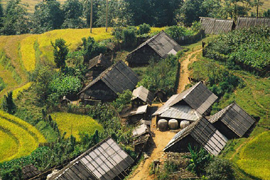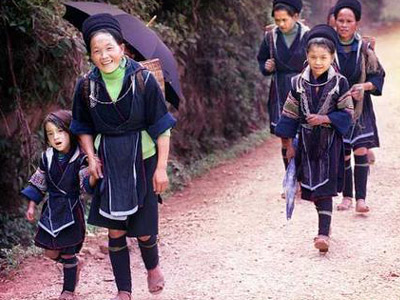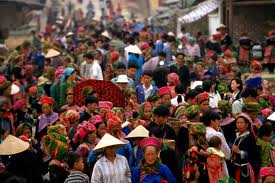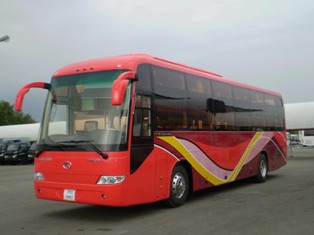Tour Code :HBK 03 - Sapa Cycling Tour
3 Days/4nights - Daily Departure from Hanoi or Sapa
Itinerary:
Please, be ready at your hotel lobby at 19h.30 for a short transfer to Hanoi railways station for taking the overnight train (first class 4 beds cabin with air-condition) which arrive in Lao Cai city, near the Chinese border next morning.
Day 1 // Sapa Town’s Highlights
The train arrives at Lao Cai station early at about 06.00, meet your guide and driver as you check out and an hour transfer uphill the Hoang Lien Son mountains to Sapa. Great views of valleys and terraced rice fields along the way.
After Breakfast your guide will show you around for a brief introduction of this charming town. At the market, ethnic minority people of different groups wearing their traditional costumes made by themselves comes every day selling local products includes vegetable, bamboo shoot, mushroom, medicinal herbs and souvenirs…there are chances to get intact and taking photos. Afterwards you will follow the footsteps uphill to the top of Ham Rong Mountain for over viewing beautiful scenery of the town and surrounding area, paying visit to an orchard garden and a mini museum which tells you a lot about ethnic minority people living in Sapa and the northwest region.
Later in the afternoon, you may wish to continue your walk down hill to visit Cat Cat village of the Black H’mong, 5 km away or drop in a local terraced café to enjoy your self as the cloud comes and goes.
- Breakfast and Lunch included, Dinner on your own
- Accommodation: Hotel in Sapa
Day 2 // Explore Ma Tra & Ta Phin Valley // Silver Waterfall
Today morning, you will explore Ma Tra and Ta Phin valley on southeast of Sa Pa town. Leaving Sapa, you will cycle along the motor way fro few kilometers, then turn to a dirt road up and down hill to visit Ma Tra Village of the H’Mong, where you will leave your bike and take a walk for an hour to different hamlets scattering from the bottom of the valley to higher mountain slopes. Continue on two wheels for another hours to center of Ta Phin Valley where you will meet groups of Red Zao women making handicrafts includes embroidered clothes, handbags… You will explore this village of the Red Zao for an hour and then set down for Lunch. Long Break with a lot of photos taken before following the main road up hill back to Sapa. The afternoon cycle 14km to the Silver Waterfall is let open on your decision then. If not cycle, you may enjoy this portion of the trip by vehicle. Arrive back to Sapa and the rest few hours is set at your leisure.
- Breakfast and Lunch included, Dinner on your own
- Accommodation: hotel in Sapa
Day 3 // Tribal Villages Exploration along Muong Hoa Valley // Night train to Hanoi
Starting your cycle from Sapa at 08.00Am, heading south along the narrow motor way downhill and the first 7km features with steep road, wild nature and spectacular scenery of Fansipan Mount on your right side and then the large view of Muong Hoa Valley opens wide suddenly. You will cross the Muong Hoa River and exploring ethnic villages including Ta Van(Zay) and Lao Chai and Su Pan(Black H’mong). Continue 12 km further south, you will see another large valley in oval shape. As you cycle along the road winding on the left side of the valley at high elevation great view of the Ban Ho Valley dominated by green fields and stilt houses stretching far away under your wheels. Descending downhill for about 20minutes you will arrive Ban Ho Village of the Tay where you will enjoy Lunch prepared in a local home. After long break for Lunch you will leave your bikes here and on foot to explore Ban Ho and nearby villages. The way back is flexible for your choice. You may choose to cycle for some portions and on vehicle for the rest of the road and arriving back to your hotel in Sapa before 05.00Pm. Take a quick shower and transfer to Lao Cai Station for the night train back to Hanoi. Which arrive the next morning and end up your trip.
- Breakfast and Lunch included, Dinner on your own
| Group Size | 2 - 3 Persons | 4 -6 Persons | 7- 10 Persons | Book it now |
|---|---|---|---|---|
| 2 star hotel | 270 | 245 | 230 | Booking now |
| 3 star hotel | 320 | 295 | 280 | Booking now |
| 4 star hotel | 395 | 375 | 350 | Booking now |
Tour price includes
- Accommodation: 2 night hotel in Sapa
- Return train tickets in 4 bed shared cabin with A/C, tourist class
- Transfer by private vehicle for group as in detail itinerary
- Good mountain bicycle with helmet
- All meals indicated in the detail itinerary, drinking water and snack when cycling
- English speaking guide and visiting fee, tax and service charge.
Tour price excludes
- Meals not indicated in day by day itinerary.
- Drinks and personal expenses.
Sapa Vietnam
-- Located in North-West Vietnam , Sapa is the most attractive mountain place must be visited on any northern Vietnam itinerary. On a clear day you will treated to views of steeply terraced rice fields, towering verdant ridgelines, primitive mud-thatched villages, raging rivers and astounding waterfalls. Nestled high in the Tonkinese Alps near the Chinese border, Sape was built as a hill station during French colonial days, to serve as a respite from stifling Hanoi summers. These days, weekends are still the biggest draw in this crumbling hill-tribe center. Visitors from the capital flock to Sapa for a glimpse of the famed "Love Market," a trek to local hill tribe villages, or an ascent of Vietnam's highest peak, Fan Si Pan. Some eight ethnic groups inhabit Lao Cai province: Hmong, Dao, White Thai, Giay, Tay, Muong, Hao and Xa Pho. The most prominent in town are the Red Dao, easily identified by the coin-dangling red headdresses and intricately embroidered waistcoats worn by the women, and the Hmong, distinguished by their somewhat less elaborately embroidered royal blue attire.

Groups of ethnic Hmong youngsters and women can be seen hauling impossibly heavy, awkward baskets of wood, stakes, bamboo, bricks, mud and produce. Deep in the valleys surrounding Sapa, the Muong Hoa River sluices a wild, jagged course among Giay, Red Dao and White Thai settlements, their tiny dwellings poking out of the neon rice fields like diamonds on a putting green. One- to four-day treks are offered by a handful of outfitters. Guests sleep in tents or in the homes of villagers, their gear hauled by Hmong porters. Be warned: Despite what the local innkeepers will tell you, both the Hmong and the Dao really do not enjoy having their photographs taken unless they're paid for it. It's a certainty that any brochure you see of smiling, care-free ethnic hill people was shot under a Screen Actors Guild contract.
Sprawling near the banks of a river, Can Cau Market is a clearly defined shantytown, packed with crude stalls covered with thatched roofs. The start of a few simple settlements can be seen high above, many of whose residents now make their weekly pilgrimage to the market. We are only 9kms from the Chinese border and some traders make the journey across from China on horseback. Unfortunately foreigners are not allowed to reciprocate this set-up, however tempting it may seem. By 9 am, the market is crammed to capacity. It's lively and surprisingly fun. The locals are mostly of the Flower Hmong minority group. You can't miss them -their traditional costume of green checked headdress and multi-colored, meticiculosly stitched and layered garments are simply stunning. Few foreigners make it to Can Cau; those that do brave the journey come either with a small tour group in four-wheel drives, or - if half-mad and on a tight budget like me -on the back of a motorbike.

The handful of Westerners here this morning are the object of intense - though friendly- scrutiny. There is much laughter as we try to make basic conversation. Although the majority are painfully shy and not accustomed to seeing foreigners, some cheerfully allow photographs to be taken.










